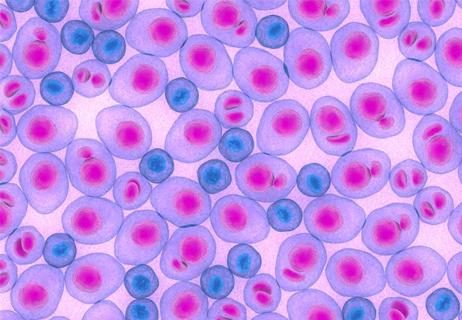Prediction and bioinformatic data could prove valuable for therapeutic interventions targeting this malignancy

A new analysis, spearheaded by a multi-institutional team of experts, highlights a computational methodology that supports the identification of multiple myeloma patients who are most suited to a particular treatment regimen, thereby contributing to improved patient care. The study also offers strategies for reducing adverse events (AEs), lowering mortality rates and ensuring the optimal allocation of healthcare resources.
Advertisement
Cleveland Clinic is a non-profit academic medical center. Advertising on our site helps support our mission. We do not endorse non-Cleveland Clinic products or services. Policy
This unique methodology consists of a collection of biomarkers from the Multiple Myeloma Research Foundation (MMRF) dataset, and use of the FDA Spontaneous Reporting System database for large-scale disproportionality analysis of multiple myeloma patients.
The investigators have collected information on severe AEs due to medications and applied pharmacogenomic insights from genomic database and multiple myeloma drug targets. They then used seven machine learning algorithms to assess the disease outcome. In the study, different biomarkers were evaluated in deceased and alive patients. The study findings were presented during an oral session at the American Society of Clinical Oncology (ASCO) annual meeting.
“Through a collaborative research effort, we are taking a closer look at multiple myeloma and how the disease, drugs and genes are interconnected,” says study author Shahzad Raza, MD, from the Department of Hematology and Medical Oncology at Cleveland Clinic. “The identification of characteristics within transcriptomic data of multiple myeloma patients could help clarify long-term disease prognosis. Our study offers insights into how artificial intelligence (AI) might be used in multiple myeloma and could help optimize future clinical trials.
“Additionally, we performed an in-depth analysis of gene expression data from multiple myeloma patients to clarify the role of specific genes in the disease’s prognosis and underlying mechanisms,” Dr. Raza says.
Dr. Raza and his colleagues conducted a large-scale disproportionality analysis of multiple myeloma patients using the FDA Spontaneous Reporting System database to identify a precise collection of biomarkers.
Advertisement
The researcher team selected 84 essential biomarkers by integrating pharmacogenomic insights from OMIM and multiple myeloma drug targets into their analysis. The classification of disease outcomes was then assessed via different machine learning algorithms, including AdaBoost, K-Nearest Neighbors (KNN), Decision Tree (DT), Gaussian Naïve Bayes (GNB), Support Vector Machine (SVM), Random Forest (RF) and Multilayer Perceptron (MLP).Gene expression data was obtained from the Multiple Myeloma Research Foundation (MMRF) CoMMpass study, which includes transcriptomic profiles of patients. A survival analysis was performed by Dr. Raza and his colleagues to compare gene expression levels between patients who survived and those who did not.
The study included 787 patients—624 alive and 163 deceased—from the MMRF. To address the influence of imbalanced data, the investigators used four sampling methods in the training and testing process on machine learning models. Those strategies included original raw data, undersampling, oversampling and simultaneous sampling.
Data showed that the Support Vector Machine algorithm reached the highest accuracy and the Random Forest machine learning tool attained the highest mean across the four sampling methods (imbalanced: 81.4%, undersampling: 81.4%, oversampling: 92.3% and simultaneous: 93.1%).
Out of 84 genes, the investigators identified 11 that are significantly correlated with overall survival among multiple myeloma patients. High expression of seven genes—ATM, CYBA, NR3C1, PIK3CA, PIK3CG, RPS19 and NFE2L2—were associated with a better overall survival, Dr. Raza reports. Inferior overall survival was linked to high expression of the following genes: BRAC1, IFNG, NTRK2 and CTLA4.
Advertisement
Differential expression analysis revealed potential biomarkers linked to multiple myeloma prognosis, Dr. Raza notes. “Integrating transcriptomic data with clinical outcomes provides important insights into disease biology and treatment responses,” he says.
Moving forward, Dr. Raza emphasizes the need for additional study and larger data sets. “Future clinical trials should incorporate computational methods to refine our approach to the management of patients with multiple myeloma,” he shares. “The next step is to test each gene in a larger data set to improve our understanding of these patients and their outcomes.
“With further study and continued collaboration, I see a practical application for these types of data that clinicians can use for the benefit of their patients and the field as a whole,” Dr. Raza concludes.
Advertisement
Advertisement

Phase 2 study brings pivotal advances in treatment efficacy and safety for the most challenging-to-treat population

Making sense of the fast-moving treatment landscape

Explaining common misconceptions about chimeric antigen receptor therapy

Clinicians share practices to streamline initiation of care

Findings from large database important to inform clinical practice

Study of 401,576 patients reveals differences in cancer burdens as well as overall survival

Despite sicker patients, response rates of teclistamab in a real-world study were similar to those from a pivotal clinical trial

Strategies and risk models are evolving for this asymptomatic condition